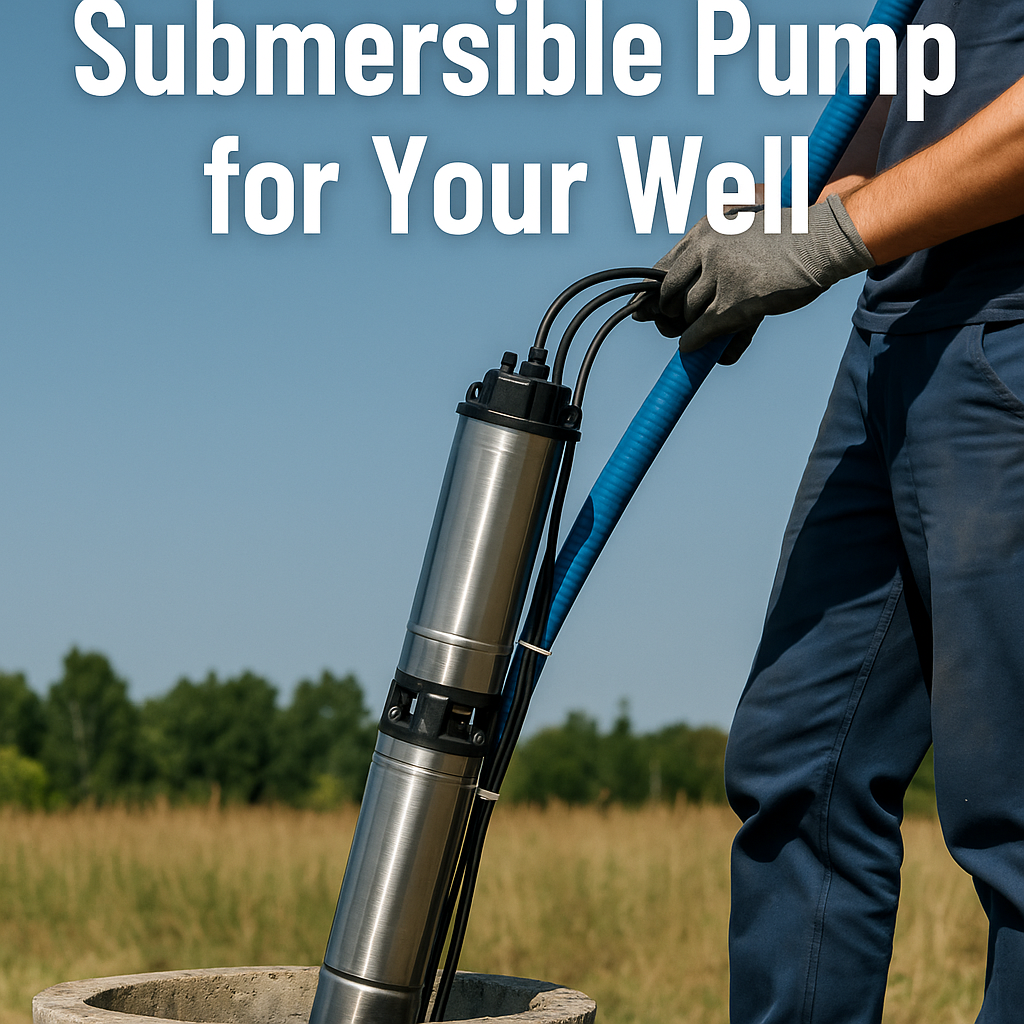- FREEE SHIPPING
- FAST DELIVERY
- FREE SHIPPING
- FAST DELIVERY
- FREE SHIPPING
- FAST DELIVERY
- FREE SHIPPING
- FAST DELIVERY
- FREE SHIPPING
- FAST DELIVERY
- FREE SHIPPING
- FAST DELIVERY


Choosing the right submersible pump for your well is critical to ensure reliable water supply, efficient performance, and long pump life. An undersized pump may fail to meet your household or irrigation needs, while an oversized pump can waste energy and damage your system. In this guide, we’ll walk you step by step on how to size a submersible pump for your well.
Before selecting a pump, collect the following data:
Well Depth (Total Depth): The total vertical depth of your well from ground surface to the bottom.
Static Water Level: The vertical distance from the ground surface to the water level when the well is at rest.
Pumping Water Level (Dynamic Level): The water level in the well while the pump is running.
Well Yield (GPM): The maximum flow rate your well can produce, measured in gallons per minute.
Casing Diameter: The inside diameter of your well casing (e.g., 4″, 6″, 8″).
Next, calculate how much water your household, farm, or facility requires. Consider:
Household use: A typical home requires 6–12 GPM. Each fixture (shower, faucet, washing machine, irrigation system) adds to total demand.
Irrigation use: Lawn sprinklers usually need 5–10 GPM each. Multiply by the number of sprinklers you plan to run simultaneously.
Commercial/Agricultural use: Higher flows may be necessary depending on application.
Pro Tip: Size the pump to meet peak demand (the highest flow needed at one time), not just average use.
The most important step in sizing your pump is calculating Total Dynamic Head (TDH) — the total pressure the pump must overcome. TDH includes:
Vertical Lift: Distance from pumping water level to pressure tank or point of use.
Friction Losses: Resistance in pipes, fittings, elbows, and valves (depends on pipe length/diameter).
Pressure Requirement: Desired pressure at your system (usually 40–60 PSI for residential, equal to 92–138 feet of head).
TDH Formula:
TDH = Vertical Lift (ft) + Friction Loss (ft) + Pressure Requirement (ft)Once you know the required flow (GPM) and TDH (ft), check manufacturer pump performance curves. Select a pump model that delivers your required flow at your TDH point.
If the pump curve shows the pump delivers 10 GPM at 235 ft TDH, it’s a good fit.
Always choose a pump operating near the middle of its curve for best efficiency and longevity.
Pump Diameter: Must fit inside your well casing (e.g., use a 4″ pump for a 4″ casing).
Motor Horsepower (HP): Depends on flow and head requirements. For example, 1 HP can handle around 10–12 GPM at 200 ft TDH.
Material: Stainless steel or Noryl impellers for durability in different water conditions.
Pressure Tank: Ensure correct sizing to reduce pump cycling.
Voltage: Match pump motor to your available power (115V, 230V, or 460V).
Water Quality: If your water has sand, iron, or corrosive properties, choose pumps designed for those conditions.
Sizing a submersible pump correctly ensures your well delivers consistent water pressure, prevents premature pump failure, and saves energy costs. By calculating your flow demand, TDH, and checking pump curves, you’ll select the right pump the first time.
At Pump Supermarket, we stock submersible pumps from 2″ up to 12″, with horsepower ranging from fractional to industrial scale. Our experts can help you calculate TDH, select the proper pump, and ship the right model from our Miami warehouse — often within 1 hour of your order.
👉 Need help sizing your pump? Contact us today and we’ll match the best submersible pump for your well.
1) How do I calculate Total Dynamic Head (TDH)?
Add vertical lift (from pumping water level to pressure tank), friction loss in pipe/fittings, and required pressure (PSI × 2.31 = feet). Example: 100 ft lift + 20 ft friction + (50 PSI × 2.31 = 115 ft) = 235 ft TDH.
2) What flow rate (GPM) do most homes need?
Typical homes need 6–12 GPM. Add up simultaneous fixtures (showers, faucets, irrigation zones) to estimate your peak demand.
3) What horsepower (HP) do I need?
HP depends on flow + TDH. As a rough guide, 1 HP can handle ~10–12 GPM at ~200 ft TDH. Check the pump curve to be sure.
4) How do I choose between 2‑wire and 3‑wire submersible pumps?
2‑wire (plus ground) has the start components in the motor—simpler install. 3‑wire (plus ground) uses an external control box, making capacitor/relay service easier. Performance is otherwise similar—follow your existing wiring and local code.
5) Will a 4″ submersible pump fit my casing?
Most 4″ pumps are designed for 4″ casings, but check the actual OD of the pump and the ID of your casing, plus any drop pipe/cable clearance.
6) What if my well has sand or iron?
Choose pumps with abrasion‑resistant components (e.g., stainless steel or high‑grade polymer impellers/diffusers) and consider a sand separator or spin‑down filter.
7) How big should my pressure tank be?
Bigger tanks reduce cycling and extend pump life. A common rule is 1–2 gallons of drawdown per GPM of pump capacity (e.g., 10 GPM → 10–20 gallons drawdown). Check manufacturer tables.
8) How do I read a pump curve?
Find your TDH on the Y‑axis and your required GPM on the X‑axis. Choose a model whose curve passes through or just above that point—ideally near the middle of its curve for efficiency.
9) What’s the difference between static and pumping water levels?
Static is the resting level. Pumping (dynamic) is the lowered level while the pump runs. Use the pumping level for TDH calculations.
10) Can I run irrigation and the house on the same pump?
Yes—size the system for peak simultaneous demand and use a VFD/constant‑pressure system or zone your irrigation to avoid starving household fixtures.